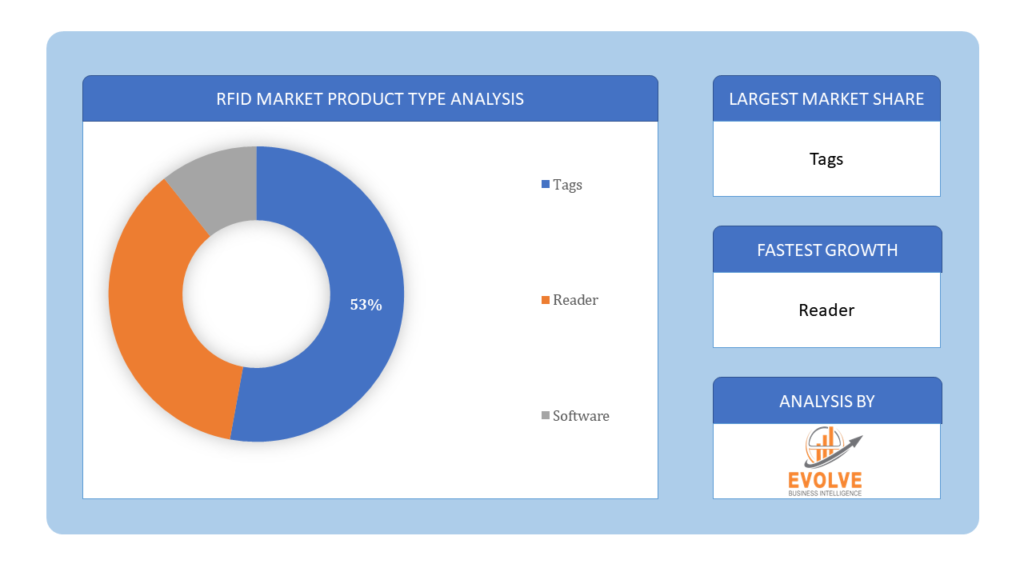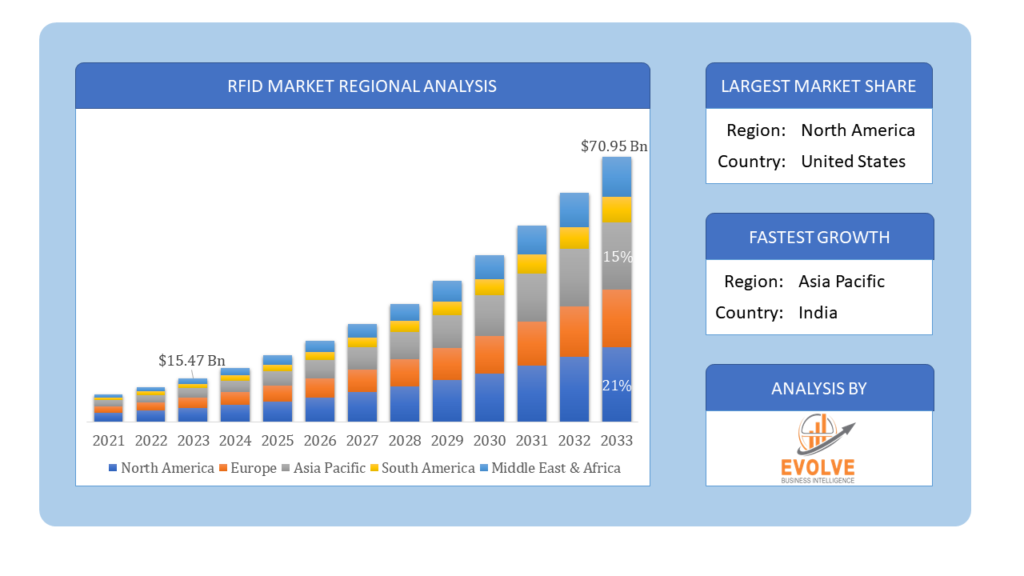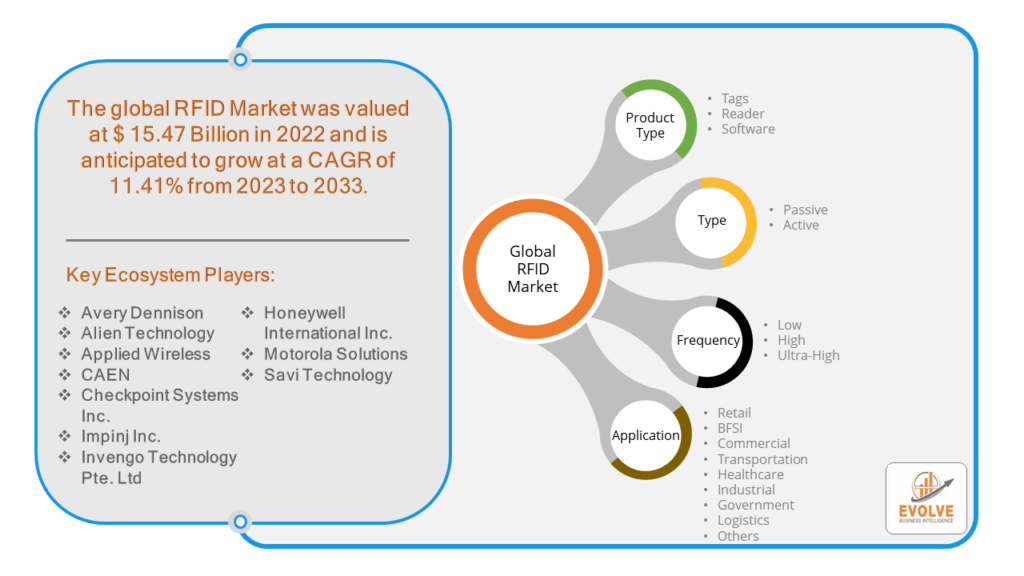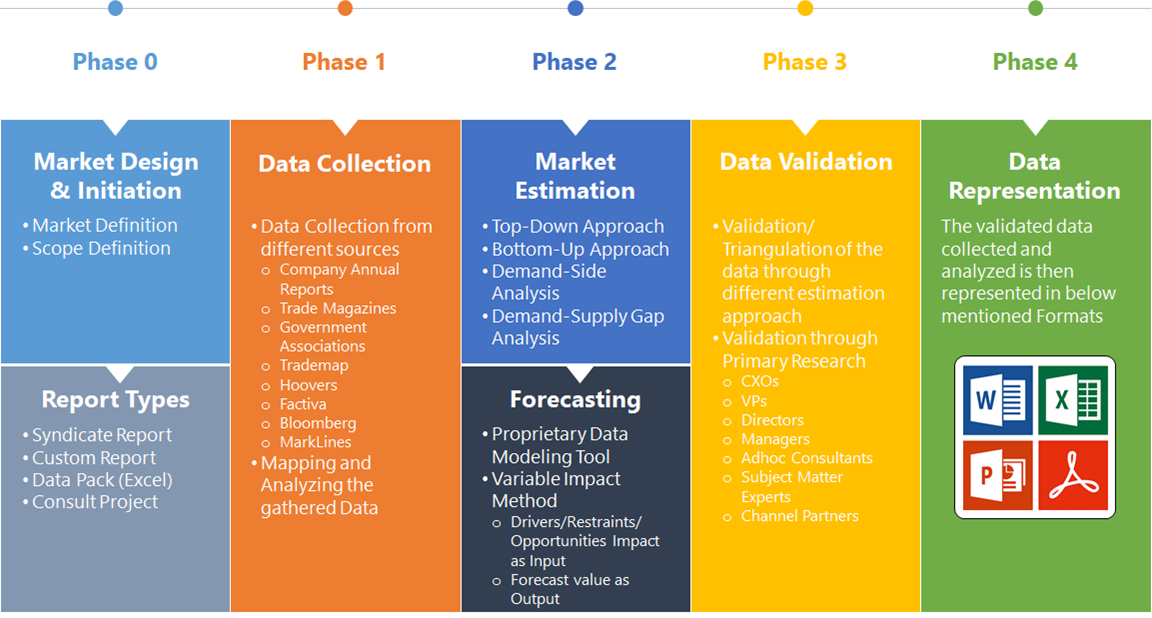RFID Market Overview
RFID Market Size is expected to reach USD 70.95 Billion by 2033. The RFID industry size accounted for USD 15.47 Billion in 2023 and is expected to expand at a compound annual growth rate (CAGR) of 11.41% from 2023 to 2033. The Radio-Frequency Identification (RFID) market encompasses technology that uses radio waves to identify and track objects or individuals wirelessly. RFID systems consist of tags or labels attached to the objects, readers that transmit the radio signals, and a database for storing information. Industries such as retail, healthcare, logistics, and manufacturing widely adopt RFID for inventory management, asset tracking, and supply chain optimization. The market is driven by the need for real-time visibility, improved operational efficiency, and enhanced security. Advancements like passive and active RFID systems, along with developments in IoT and cloud computing, are shaping the market’s growth trajectory. Global RFID market size is projected to expand significantly due to increasing applications across various sectors and ongoing technological innovations.
Global RFID Market Synopsis
The RFID market experienced a detrimental effect due to the Covid-19 pandemic. The COVID-19 pandemic has had a mixed impact on the RFID market. While initial disruptions in supply chains and manufacturing slowed down deployments, the need for contactless solutions and supply chain visibility accelerated RFID adoption in sectors like healthcare, retail, and logistics. The pandemic highlighted the importance of RFID in enabling real-time tracking of essential goods, ensuring inventory management efficiency, and enhancing safety measures such as contactless payments and access control. As economies recover and industries adapt to the new normal, the RFID market is poised for steady growth driven by continued demand for automation, efficiency, and improved safety protocols.
Global RFID Market Dynamics
The major factors that have impacted the growth of RFID are as follows:
Drivers:
⮚ Advancements in Healthcare
In healthcare, RFID is used for patient identification, medication management, asset tracking, and supply chain optimization. The increasing adoption of electronic health records (EHR) and the need for patient safety and compliance with regulations further drive the integration of RFID technology in healthcare settings.
Restraint:
- Privacy Concerns
RFID technology raises concerns about privacy and data security, particularly regarding the collection and use of personal information. Issues such as unauthorized tracking, data breaches, and identity theft can lead to public apprehension and regulatory scrutiny, potentially hindering widespread adoption, especially in consumer-facing applications.
Opportunity:
⮚ Smart Packaging
RFID-enabled smart packaging offers opportunities for product authentication, anti-counterfeiting measures, and enhanced customer engagement through interactive packaging experiences.
RFID Market Segment Overview
By Product Type
 Based on the Product Type, the market is segmented based on Tags, Reader, and Software. With a revenue contribution of roughly 45–48% to the Radio-Frequency Identification (RFID) Market in 2021, the tags segment had the lion’s share of the market. It is also projected that this market sector will increase at the quickest rate.
Based on the Product Type, the market is segmented based on Tags, Reader, and Software. With a revenue contribution of roughly 45–48% to the Radio-Frequency Identification (RFID) Market in 2021, the tags segment had the lion’s share of the market. It is also projected that this market sector will increase at the quickest rate.
By Type
Based on Type, the market has been divided into Passive and Active. Due to the quick uptake and increased demand for Radio-Frequency Identification (RFID) for product tracking across a number of end-use sectors, Passive RFID retained the biggest segment share in 2021.
By Frequency
Based on the Frequency, the market has been divided into Low, High, Ultra-High. Due to the widespread use of UHF tags—which are more widely available and have a greater reading range of up to 15 meters when compared to both low- and high-frequency RFID—ultra-high frequency (UHF) maintained the greatest segment share in 2021.
By Application
Based on Application, the market has been divided into Retail, BFSI, Commercial, Transportation, Healthcare, Industrial, Government, Logistics, and Others. Having dominated the market in 2021, the retail category is expected to grow at the fastest rate between 2022 and 2030. This is because more companies are using RFID to control inventories, which is the reason for this.
Global RFID Market Regional Analysis
Based on region, the market has been divided into North America, Europe, Asia-Pacific, the Middle East & Africa, and Latin America. The area of North America is anticipated to dominate the market for the usage of RFID , followed by those in Asia-Pacific and Europe.
 RFID North America Market
RFID North America Market
The North American region holds a dominant position in the RFID market. With a $4.7 billion market, North America led the RFID industry in 2017. Due to the expansion of industries including healthcare and medicine, security systems, retail, government efforts, and ongoing demand for the newest technology, North America is projected to grow at a CAGR of 13.4% by 2027. Therefore, among all the regions, North America is predicted to increase at the fastest rate.
RFID Asia Pacific Market
The Asia-Pacific region is witnessing rapid growth and emerging as a significant market for the RFID industry. The RFID market in Asia-Pacific is anticipated to expand at the quickest rate of compound annual growth (CAGR) between 2022 and 2030. This is because the retail industry is growing and adopting automation and IoT at a faster rate. Furthermore, the India Radio-Frequency Identification (RFID) market was the fastest-growing market in the Asia-Pacific region, while China retained the biggest market share.
Competitive Landscape
The competitive landscape includes key players (tier 1, tier 2, and local) having a presence across the globe. Companies such as Avery Dennison, Alien Technology, Applied Wireless, CAEN, and Checkpoint Systems Inc. are some of the leading players in the global RFID Industry. These players have adopted partnership, acquisition, expansion, and new product development, among others as their key strategies.
Key Market Players:
- Avery Dennison
- Alien Technology
- Applied Wireless
- CAEN
- Checkpoint Systems Inc.
- Impinj Inc.
- Invengo Technology Pte. Ltd
- Honeywell International Inc.
- Motorola Solutions
- Savi Technology
Key Development:
On 2nd February 2020, Avery Dennison declared that they have acquired SMARTRAC’s RFID transponder business. SMARTRAC is one of the topmost manufacturers in RFID inlays. They are very well known for innovating and developing high- quality RFID products and also for their thorough research and development capabilities.
Scope of the Report
Global RFID Market, by Product Type
- Tags
- Reader
- Software
Global RFID Market, by Type
- Passive
- Active
Global RFID Market, by Frequency
- Low
- High
- Ultra-High
Global RFID Market, by Application
- Retail
- BFSI
- Commercial
- Transportation
- Healthcare
- Industrial
- Government
- Logistics
- Others
Global RFID Market, by Region
- North America
- US
- Canada
- Mexico
- Europe
- UK
- Germany
- France
- Italy
- Spain
- Benelux
- Nordic
- Rest of Europe
- Asia Pacific
- China
- Japan
- South Korea
- Indonesia
- Austalia
- Malaysia
- India
- Rest of Asia Pacific
- South America
- Brazil
- Argentina
- Rest of South America
- Middle East & Africa
- Saudi Arabia
- UAE
- Egypt
- South Africa
- Rest of Middle East & Africa
| Parameters | Indicators |
|---|---|
| Market Size | 2033: $70.95 Billion |
| CAGR | 11.41% CAGR (2023-2033) |
| Base year | 2022 |
| Forecast Period | 2023-2033 |
| Historical Data | 2021 |
| Report Coverage | Revenue Forecast, Competitive Landscape, Growth Factors, and Trends |
| Key Segmentations | Product Type, Type, Frequency, Application |
| Geographies Covered | North America, Europe, Asia-Pacific, Latin America, Middle East, Africa |
| Key Vendors | Avery Dennison, Alien Technology, Applied Wireless, CAEN, Checkpoint Systems Inc., Impinj Inc., Invengo Technology Pte. Ltd, Honeywell International Inc., Motorola Solutions, Savi Technology |
| Key Market Opportunities | Emergence of biomaterial Radio-Frequency Identification (RFID) implants |
| Key Market Drivers | Rising prevalence of cervical spondylosis in corporate professionals Growing cases of cervical injuries in automobile crashes |
REPORT CONTENT BRIEF:
- High-level analysis of the current and future RFID Industry trends and opportunities
- Detailed analysis of current market drivers, restraining factors, and opportunities analysis in the future
- Historical market size for the year 2021, and forecast from 2023 to 2033
- RFID market share analysis for each segment
- Competitor analysis with a comprehensive insight into its product segment, financial strength, and strategies adopted.
- Identifies key strategies adopted by the key players including new product development, mergers and acquisitions, joint ventures, collaborations, and partnerships.
- To identify and understand the various factors involved in the global RFID market affected by the pandemic
- To provide year-on-year growth from 2022 to 2033
- To provide short-term, long-term, and overall CAGR comparison from 2022 to 2033.
- Provide Total Addressable Market (TAM) for the Global RFID Market.





